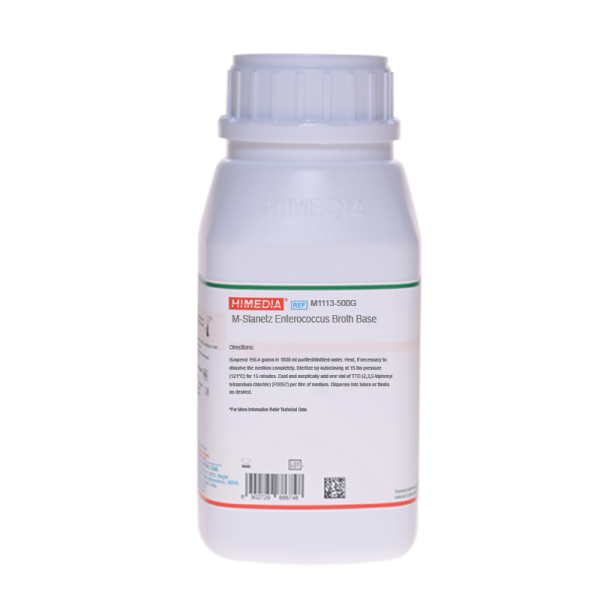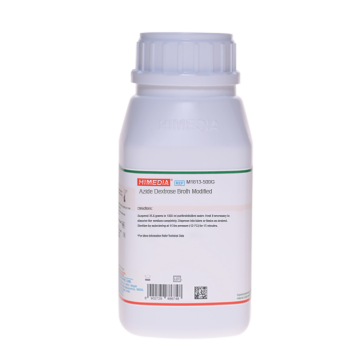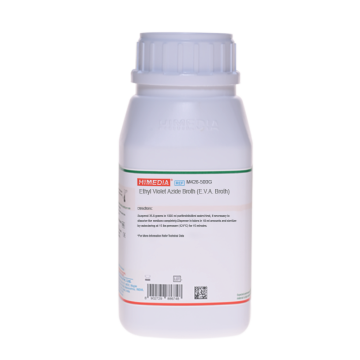 Your enquiry has been submitted
Your enquiry has been submitted
M-Slanetz Enterococcus Broth Base
Plate Count#CC293D
Intended Use
Recommended for isolation and detection of Enterococci using membrane filtration technique.
Composition
| Ingredients | g / L |
|---|---|
| Tryptone | 25.000 |
| Peptone | 15.000 |
| Yeast extract | 10.000 |
| Dextrose (Glucose) | 2.000 |
| Sucrose | 100.000 |
| Dipotassium hydrogen phosphate | 4.000 |
| Sodium azide | 0.400 |
Final pH (at 25°C): 7.1±0.2
Formula adjusted, standardized to suit performance parameters
Directions
Suspend 156.4 grams in 1000 ml purified/distilled water. Heat, if necessary to dissolve the medium completely. Sterilize by autoclaving at 15 lbs pressure (121°C) for 15 minutes. Cool and aseptically add one vial of TTC (2,3,5-triphenyl tetrazolium chloride) (FD057) per litre of medium. Dispense into tubes or flasks as desired.
Principle And Interpretation
The membrane filter technique is employed when relatively large sample volumes are to be analyzed. This technique is highly reproducible and more rapid. Membrane filters are aseptically placed on sterile cotton absorbent filter pads saturated with the appropriate media. The Enterococci portion of the faecal Streptococcus group is a valuable bacterial indicator for determining the extent of faecal contamination of recreational surface waters (1). M-Slanetz Enterococcus Broth Base is formulated according to Slanetz and Bartley (2) for the isolation and detection of Enterococci using the membrane filter technique (3). This medium is a modification of M- Enterococcus Agar developed by Slanetz, Bent and Bartley (4). Tryptone, peptone and yeast extract provide necessary nutrients like nitrogenous compounds and vitamin B complex. Dextrose and sucrose are the fermentable carbohydrate sources in the medium. Dipotassium phosphate helps in buffering the medium. Sodium azide inhibits the growth of most of the accompanying gram-negative microbial flora. Triphenyl Tetrazolium Chloride is reduced by Enterococci to formazan, a red coloured complex inside the bacterial cell resulting in the formation of red coloured colonies.
Type of specimen
Water samples
Specimen Collection and Handling
Saturate sterile absorbent cotton pads with M-Slanetz Enterococcus Broth Base. Aseptically place the membrane filters, through which water sample is passed, onto these saturated sterile absorbent cotton pads. Incubate at 35-37°C for 40-48 hours. Enterococci will form red coloured colonies on the surface of filter membranes. Refer appropriate references for standard procedures (1). After use, contaminated materials must be sterilized by autoclaving before discarding.
Warning and Precautions
Read the label before opening the container. Wear protective gloves/protective clothing/eye protection/face protection. Follow good microbiological lab practices while handling specimens and culture. Standard precautions as per established guidelines should be followed while handling specimens. Safety guidelines may be referred in individual safety data sheets.
Limitations
- Further biochemical testing is required for identification of species.
- Individual organisms differ in their growth requirement and may show variable growth patterns on the medium.
- Each lot of the medium has been tested for the organisms specified on the COA. It is recommended to users to validate the medium for any specific microorganism other than mentioned in the COA based on the user's unique requirement.
Performance and Evaluation
Performance of the medium is expected when used as per the direction on the label within the expiry period when stored at recommended temperature.
Quality Control
Appearance Cream to yellow homogeneous free flowing powder
Colour and Clarity of prepared medium Yellow coloured clear solution (may have slight precipitate)
Reaction Reaction of 15.6% w/v aqueous solution at 25°C. pH: 7.1±0.2
pH 6.90-7.30
Cultural Response Cultural characteristics observed on membrane filter after an incubation at 35-37°C for 40-48 hours
| Organism | Inoculum (CFU) | Growth | Colour of colony (on membrane filter) |
|---|---|---|---|
| Escherichia coli ATCC 25922 (00013*) | >=104 | inhibited | |
| Enterococcus faecalis ATCC 29212 (00087*) | 50-100 | luxuriant | red- maroon |
Key: *Corresponding WDCM numbers.
Storage and Shelf Life
Store between 10-30°C in a tightly closed container and the prepared medium at 2-8°C. Use before expiry date on the label. On opening, product should be properly stored dry, after tightly capping the bottle in order to prevent lump formation due to the hygroscopic nature of the product. Improper storage of the product may lead to lump formation. Store in dry ventilated area protected from extremes of temperature and sources of ignition. Seal the container tightly after use. Product performance is best if used within stated expiry period.
Disposal
User must ensure safe disposal by autoclaving and/or incineration of used or unusable preparations of this product. Follow established laboratory procedures in disposing of infectious materials and material that comes into contact with sample must be decontaminated and disposed of in accordance with current laboratory techniques (5,6).
Reference
- Lipps WC, Braun-Howland EB, Baxter TE, eds. Standard methods for the Examination of Water and Wastewater, 24th ed. Washington DC:APHA Press; 2023.
- Slanetz L. W. and Bartley C. H., 1957, J. Bacteriol., 74: 591.
- MacFaddin J. F., 1985, Media for Isolation-Cultivation-Identification-Maintenance of Medical Bacteria, Vol. 1, Williams and Wilkins, Baltimore.
- Slanetz L. W., Bent D. and Bartley C. H., 1955, Public Health Rep.,70: 67.
- Isenberg, H.D. Clinical Microbiology Procedures Handbook 2nd Edition.
- Jorgensen, J.H., Pfaller, M.A., Carroll, K.C., Funke, G., Landry, M.L., Richter, S.S and Warnock., D.W. (2015) Manual of Clinical Microbiology, 11th Edition. Vol. 1.
| Product Name | M-Slanetz Enterococcus Broth Base |
|---|---|
| SKU | M1113 |
| Product Type | Regular |
| Physical Form | Powder |
| Origin | Animal |
| Packaging type | HDPE |
| References | 1. Eaton A. D., Clesceri L. S. and Greenberg A. E., (Ed.), 1998, Standard Methods for the Examination of Water andWastewater, 20th Ed., American Public Health Association, Washington, D.C. |
| Customized Product Available | No |








